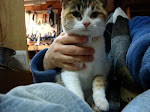I check on the chickens about mid-day most days. Today's check, as all others, included an inspection of the eggs under my broody girls. Little Squeaky is sitting on six banty eggs. I presume they are all hers as there is no variation. She might be a mama about June 17th although the quality of her shells is not great. She's the first of our Cochins to go broody and could use the time away from the roosters to regrow her feathers. The big girls seem utterly disinclined but that's OK as they earn their keep with great big eggs.
Miss Bett has been on her clutch for about a month. The girls seem to like to spend a week or two collecting eggs in their nest before getting down to the business of incubation. The magic number of eggs around Stratheden seems to be five, real or fake, acquired over several days. (They'd like more.) As you can see from the picture, today was hatch day! All came from large eggs.
Two chicks seem to have bantam Cochin daddys. That cute yellow chick is a biggie but my red roosters are both bantams, so it's counted as a bantam x. Another is all black and comparatively small. Four of the chicks have feathered legs which confirms Cochin parentage. We'll have to wait until these babies grow proper feathers (about four weeks) to know if any of the chicks are "frizzled." Three chicks have the classic markings of a Dominique chick. All their head spots seem fairly compact, suggesting they are females.
Two chicks seem to have bantam Cochin daddys. That cute yellow chick is a biggie but my red roosters are both bantams, so it's counted as a bantam x. Another is all black and comparatively small. Four of the chicks have feathered legs which confirms Cochin parentage. We'll have to wait until these babies grow proper feathers (about four weeks) to know if any of the chicks are "frizzled." Three chicks have the classic markings of a Dominique chick. All their head spots seem fairly compact, suggesting they are females.
When Bett went broody again I decided to test an old wive's tale about sexing by egg shape. I took away any egg that was especially round or (more often) long as the books say neither produces "good chickens." (Whatever that may mean.) I then removed any particularly pointy egg on the theory that well pointed eggs are more often roosters. This left just the lovely, slightly rounded, "female" eggs.
In another day or so I should be able to "wing feather sex" them to determine how many girls and boys we have.




















